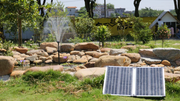
The electric bill thuds into your mailbox, and you experience a familiar shock: How can a small backyard pond use this much electricity? With pumps, filters, lights, and waterfalls, even a hobby-sized water garden can suck more power than a fridge. The good news? You can slash those kilowatts—often by 50 percent or more—without compromising water clarity, fish health, or the calming soundtrack of running water. The solution is to cut excess equipment, right-size the remaining components, and trade energy-guzzlers for Poposoap's solar-powered substitutes.
Introduction: Cut the Clutter, Cut the Cost
Most ponds don't start out as money pits. Over time, however, we add a more brilliant light here, a larger pump there, perhaps an additional UV clarifier "just in case." Each gizmo seems insignificant—until they all whir together 24-7. Streamlining your pond equipment isn't so much about doing without as it is allowing a smaller group of smarter devices to do the hard work. The reward appears every month in smaller bills and reduced maintenance headaches.
Understand Which Pond Equipment Uses the Most Energy
1. Continuous-duty pumps
Standard AC waterfall or filtration pumps often draw 40–90 watts. Running all day, one 60 W unit burns about 44 kWh per month—a hidden $9–$15 on many utility rates.
2. External pressure filters with UV
UVC lamps add another 10–40 watts. Worse, many owners forget to switch them off once algae season passes.
3. Halogen or incandescent pond lights
A string of three 20 W bulbs left on each evening can exceed the consumption of the pond’s circulation pump.
4. Over-sized aerators
High-output air pumps designed for koi farms gulp 30 W or more. In lightly stocked garden ponds, they’re serious overkill.
By contrast, Poposoap’s latest fish pond equipment—solar fountain pumps (10–25 W panels, brushless DC motors) and all-in-one solar pond filters—draw power only when the sun shines or from a built-in battery that recharges for free. Even their AC units focus on right-sizing: a compact 40 W pond filter kit handles 600 gallons without the 100-plus-watt appetite of commercial units.
Step-by-Step: How to Simplify Your Pond System
Step 1 – Audit Every Plug
Spend one afternoon unplugging each device, reading its wattage plate, and noting run-time. Many hobbyists discover duplicate pumps pushing water through the same biofilter, or a forgotten UV barrel running year-round.
Step 2 – Eliminate Redundancies
If you have a waterfall pump and a filter pump, test whether the waterfall flow alone achieves your turnover goal (aim for once per hour in koi ponds, once per two hours in wildlife ponds). One correctly sized line often replaces two.
Step 3 – Downsize With Solar Swaps
Replace AC circulation units up to about 300 gallons with a Poposoap Solar Fountain Pump. Models from 10 W to 25 W move 120–320 GPH—plenty for small to medium features. For filtration, pair with a Poposoap 20 W Solar Pond Filter that tucks mechanical sponges and bio-media into one sun-powered box. Larger ponds can use a solar pump by day and a smaller, efficient AC pump on a timer for nights—still halving daily consumption.
Step 4 – Convert Lighting to LED Solar
Swap halogen spotlights for Poposoap RGB Solar Pond Lights. They charge by day, glow automatically at dusk, and shut off before dawn, eliminating phantom loads.
Step 5 – Add Battery Back-up Selectively
For ponds stocked with valuable koi, combine a solar pump with a Poposoap 4400 mAh Battery Pack. The battery kicks in after sunset or during storms, ensuring oxygen without grid draw. Because it powers only a high-efficiency DC motor, a single charge can bridge most cloudy spells.
Energy-Saving Tips for Pond Owners
- Dial back flow rates. Most koi thrive at 1–1.5 total pond turnovers per hour. Pushing double that rate wastes energy and strips plants of CO₂.
- Run UV only when water blooms. Install the lamp on a dedicated switch or smart plug; algae typically spikes for a few weeks in spring and late summer, not year-round.
- Use gravity where possible. Placing the filter slightly above water level lets clean water return via gravity, letting the pump fight only the rise to the filter, not the whole waterfall lift.
- Shade the water. Floating lilies or a Poposoap floating fountain reduce solar gain, keeping water cooler and oxygen levels higher so you can run aerators less.
- Set timers for lights. Even solar LEDs benefit from limits; cutting two hours per night can double battery life, extending component lifespan.
How Much You Can Save (Example Calculations)
Scenario A – Traditional Setup
- 60 W AC pump, 24 h/day → 43.2 kWh/mo
- 18 W UV, 24 h/day → 13 kWh/mo
- 3 × 20 W halogen lights, 6 h/night → 10.8 kWh/mo
- Total: ≈ 67 kWh monthly
- At $0.23 per kWh (typical U.S. summer rate), that’s $15.41 every month—or $185 per year.
Scenario B – Simplified Solar Hybrid
- Poposoap 20 W Solar Pond Filter: 0 kWh grid power
- Poposoap 4400 mAh battery (charging from the panel) keeps flow overnight: 0 kWh grid power
- Poposoap LED solar lights, 5 h/night: 0 kWh grid power
- Backup 25 W AC pond pump on timer, 8 h/night (coolest hours): 6 kWh/mo
- New Total: 6 kWh monthly → $1.38 per month, $16.50 per year
Annual savings: roughly $170—and that’s on a single 600-gallon pond. Larger systems with two or three pumps often recoup several hundred dollars each year by following the same simplification playbook.
Conclusion: Smarter Ponding for Lower Bills
Electricity doesn’t have to be the hidden cost of backyard water bliss. By auditing gear, trimming duplicates, and leaning on Poposoap’s line of solar pumps, filters, and lights, you turn your pond from power sponge to self-sustaining oasis. The payoff isn’t just a smaller bill; it’s quieter operation, fewer tangled cords, and the satisfaction of knowing sunlight—not fossil fuel—is driving the gentle current that keeps your fish healthy and your water sparkling.
Cut the clutter, cut the cost, and enjoy a simpler, smarter pond all year long.










